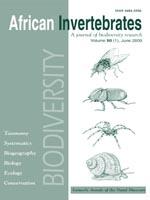The fauna and flora of tropical West Africa are, for the most part, poorly studied and little information, all of it non-technical, is available to visitors and residents alike. Even specialized information is limited, as is evidenced by numerous review papers that do not include material or records from many West African countries. This is particularly true of Gambian invertebrates (other than butterflies), which are the main focus of this book.
The book includes a brief introduction, which summarises what is known about the Gambian fauna and flora and the climate and geology of The Gambia, including colour photographs of different habitat types. This is followed by the field guide section, which is comprehensively illustrated by beautiful close-up colour photographs of live animals taken in the field. Sections include: Flowering Plants (102 photos), Fungi (16 photos), Mammals & Birds (18 photos), Reptiles & Amphibians (28 photos), Dragonflies & Damselflies (14 photos), Cockroaches (4 photos), True Bugs (32 photos), Grasshoppers & Crickets (10 photos), Antlions & Lacewings (9 photos), Termites (4 photos), Mantids, Earwigs & Web Spinners (12 photos), Beetles (54 photos), Moths & Butterflies (90 photos), Ants (8 photos), Sawflies, Bees & Wasps (28 photos), True Flies (22 photos), Spiders (78 photos), Other Arachnids (12 photos), and Millipedes & Centipedes (8 photos). The book concludes with short sections on biodiversity and conservation issues, and on additional resources for those wanting to seek further information. The final page of acknowledgements includes names of internationally-recognized taxonomists who assisted the author; this adds confidence in the identifications provided, many of which are to genus and species levels.
Apart from being an extremely useful introduction to the flora and fauna for a general readership, the work is also of important scientific value. Many of the species illustrated represent new records for The Gambia and even West Africa. This is true even for well-studied groups such as butterflies, e.g. Azanus ubaldus (Lycaenidae), previously unknown in The Gambia! Most of the spiders represent new records of taxa previously known only from eastern Africa and this is probably true also for many of the other insects. The order Ricinulei represents the first Gambian record and the northernmost record on the African continent. Several photos also illustrate extremely interesting behaviour, including predation in several groups including dragonflies, spiders, bugs and flies; Camouflage and mimicry in bugs, beetles, moths and spiders; milking of scale insects; harvesting of insect eggs and colony migration by ants; parasitic behaviour of wasps on spiders and cockroaches; and even parasites of humans represented by a tumbu fly larva and a tick both firmly embedded in the skin of the author.
There are clearly additional species not illustrated in this guide (full coverage would be a huge undertaking), but having visited The Gambia myself, I can state that this book covers those most likely to be seen during a short visit. The book is primarily aimed at identification in the field, so text has been kept to a minimum. It should be of interest to anybody with even a passing interest in the natural history of The Gambia and West Africa in general and it is good value for money, given the low price and large number of high quality photographs. The author is a Visiting Research Fellow at the University of Manchester, UK, who has spent several years living in The Gambia.






